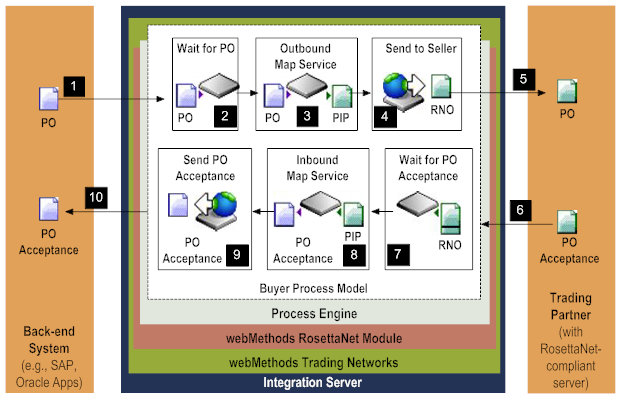
Step | Description |
1 | Enterprise is the initiator (buyer). Your internal (back-end) system generates a purchase order (PO) and submits it to RosettaNet Module. RosettaNet Module receives the PO and invokes a Trading Networks service to match the document to a TN XML document type. RosettaNet Module wraps the PO in a BizDocEnvelope and saves the BizDocEnvelope in the database using Trading Networks service. |
2 | RosettaNet Module passes the BizDocEnvelope to Process Engine. Process Engine searches for a running process instance with a matching ConversationID. If Process Engine does not find one, it starts a new conversation (process). At the Receive PO step, a service retrieves the Trading Networks profiles for the sender, receiver, and the TPAs. |
3 | An outbound mapping service maps the internal PO into a RosettaNet PIP. |
4 | At the Send to Seller step, a service packages the PIP into a RosettaNet object (RNO) and sends the RNO to the trading partner (the seller). |
5 | Now on the receiver’s side, the trading partner receives the PO, validates it, and sends a Receipt Acknowledgment (not illustrated). |
6 | The trading partner returns a PO Acceptance as a RNO, sent to your enterprise through RosettaNet Module. Trading Networks receives the PO Acceptance and extracts the ConversationID. Trading Networks then passes the PO Acceptance to Process Engine. |
7 | Process Engine continues the conversation by matching the ConversationID from the PO Acceptance with the ConversationID in the already running process instance. Once the conversation resumes, the PO Acceptance is validated, and your enterprise sends a Receipt Acknowledgment (not illustrated) to the trading partner. |
8 | Process Engine invokes an inbound mapping service which maps the PO Acceptance from a PIP to the format used by your internal system. |
9 | At the Send PO Acceptance step, a custom-created service sends the PO Acceptance to your internal system. |
10 | Your internal system receives the PO Acceptance. |